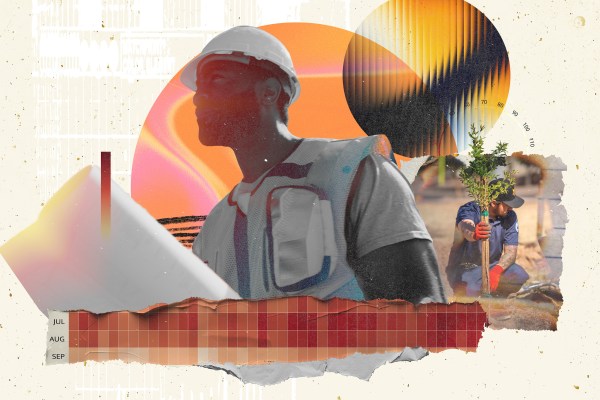
In today’s rapidly shifting economic landscape, understanding the American working class is central to the well-being of the United States’ society and the strength of our democracy. Workers are not abstract figures in labor statistics; they are parents trying to secure a better future for their children, neighbors contributing to community life, and individuals navigating the growing challenges of making ends meet. When workers face wage stagnation, erratic schedules, unsafe conditions, or a lack of essential benefits, these harms don’t remain confined to the workplace: They ripple outward, affecting families, health, civic engagement, and the social fabric that binds us all.
As the director of the Ford Foundation’s Future of Work(ers) program, I have partnered with grantees who work tirelessly, every day, to improve the rights and lives of workers across the United States. While it’s clear that millions of workers are facing increasingly precarious conditions, it’s equally clear that they are not passive victims of economic change. Throughout the country, working people are building power, forming new alliances, and envisioning solutions that are reshaping our collective future. Philanthropy has a critical role to play in fueling this momentum by investing in worker-led movements and supporting systemic change.
Defining the American Working Class
The term “working class” often evokes narrow and outdated images in American culture. But in reality, today’s working class is often primarily defined by education rather than occupation: individuals without a four-year college degree. By that measure, the working class constitutes over 60% of the U.S. labor force—more than 93 million people as of 2023. This group is not only large, but richly diverse: Roughly 53% are non-Hispanic white, 13% Black, and 25% Hispanic. Approximately 44% are women.
Today’s Working Class
More Than93 MillionPeople as of 2023
Constitutes over60%U.S Labor Force
Understanding this demographic is essential because their experiences are the most widely shared in our country. Their challenges—whether economic insecurity, limited mobility, or insufficient labor protections—shape the broader trajectory of our economy and democracy. Polls consistently show that across race, gender, geography, and political affiliation, Americans rank wages and worker well-being among their top concerns. Given the size of the working class, funders must take this as a mandate: Supporting the working class is not a niche endeavor but a national imperative.
A significant portion of the working class is employed in essential sectors such as the service industry, construction, manufacturing, agriculture, and transportation. In fact, 78% of working-class individuals are in the service sector alone, with another 13% in construction and 8% in manufacturing. These are the home health aides, janitors, warehouse workers, bus drivers, retail staff, and food service employees who keep the country running.
Yet despite their essential contributions, these workers often receive the lowest wages. In May 2023, the median hourly wage for cashiers was just $14. Home health aides and janitors each earned $16.
Precarity in the Modern Workplace
A concerning and growing subset of working-class employment is what economists call “precarious work”: positions that are unstable, poorly compensated, and stripped of protections. Gig work, temp jobs, subcontracted labor, and on-demand scheduling all fall into this category. Today, precarious work accounts for 30% to 50% of all jobs in the United States.
For example, the Worker’s Justice Project’s Delivering Justice Report details how app-based delivery workers are often misclassified as independent contractors, resulting in them not being entitled to minimum wage protections. Their earnings can drop as low as $7.09 per hour after expenses. “Just-in-time” scheduling practices, which use software to cancel or extend employee shifts on short notice based on demand, are prevalent in retail and hospitality and leave workers scrambling to balance volatile work hours with family life, childcare, and other responsibilities. Algorithmic management—the use of data and automation to assign shifts, evaluate performance, and distribute work—further adds to this precarity.
These trends erode job quality, strip workers of agency, and corrode trust in economic institutions. The rise of precarious work is not an accident but the result of deliberate policy and corporate decisions designed to minimize labor costs. The consequences are profound: diminished financial security, increased stress, and reduced opportunities for advancement.
More Than Wages: A Holistic View of Working-Class Challenges
While stagnant wages are a major concern, they are just one part of the puzzle. In 2022, the annual income for workers aged 25 and older without a college degree ranged from $35,000 – $44,000 compared to $74,000 for workers with a bachelor’s degree.
In 2022, the annual income for workers aged 25 and older without a college degree ranged from $35,000 – $44,000 compared to $74,000 for workers with a bachelor’s degree.
Upward mobility for working-class individuals is increasingly difficult. The Washington Center for Equitable Growth points out that many large employers have adopted “flat” organizational structures with limited opportunities for advancement for frontline workers. In many cases, workers must leave their employer to secure a raise or promotion. This limits pathways to career growth and traps people in cycles of low pay.
Unemployment and underemployment further strain working-class families. In 2023, the unemployment rate for workers without a college degree was 5%, more than double that of college-educated workers (2.3%). For those with jobs, inconsistent hours make it hard to plan childcare, attend school, or maintain a second income.
In today’s workforce, the quality of a worker’s schedule is a significant factor in their job satisfaction and financial well-being. According to the American Job Quality Study, a national Gallup survey in partnership with the Families and Workers Fund and others, most American employees (62%) lack high-quality work schedules.
62%of American employees lack high-quality work schedules
This is a critical issue because high-quality schedules—defined by predictability, stability, and employee control—are linked to a number of positive outcomes, including financial security, work-life balance, and job satisfaction. Conversely, the study found that 27% of employees are in jobs with low-quality schedules, meaning they lack predictability, stability and control. Low-quality schedules are known drivers of decreased productivity and increased employee turnover.
Moreover, the benefits that once defined quality employment—paid leave, health insurance, retirement plans—are increasingly out of reach. Only 56% of workers are covered by the Family and Medical Leave Act, and coverage rates are lower still for low-wage employees. Caregiving responsibilities exacerbate this crisis. Caring Across Generations’ research has found that family caregivers, especially women, spend an average of $7,000 annually on out-of-pocket care, often without any employer support or flexibility.
These stressors accumulate. Over time, they degrade mental and physical health, limit educational opportunities, and reduce family stability. The consequences aren’t just economic—they’re generational.
How Race, Gender, and Disability Shape the Working-Class Experience
While all working-class individuals face significant challenges, these are disproportionately felt by people who have historically been excluded from economic opportunity.
According to research from the Center for American Progress, working-class men earn a median income of $50,000, but women earn $40,000. This wage gap persists across sectors and contributes to long-term wealth disparities. Racial disparities are equally stark: Black and Hispanic working-class individuals earn about $40,000 on average, compared to $50,000 for white workers.
Individuals with disabilities face some of the most significant economic hurdles. Roughly 70% of disabled workers are part of the working class, and they earn just 66 cents for every dollar earned by non-disabled individuals. Adding to these challenges, low asset limits in social safety net programs, such as Supplemental Security Income (SSI), trap people with disabilities and working-class families in poverty.
To remain eligible for vital benefits, individuals must keep their savings below extremely low limits: no more than $2,000 for an individual and $3,000 for a couple. This system makes it impossible to build financial security, punishing those who try to save or work more by threatening their access to essential services like health care, and creating a cycle of dependence. Taken together, inadequate accommodations, job discrimination, asset limits, and a lack of accessible infrastructure compound inequality.
“In no U.S. state can a full-time minimum wage worker afford to rent a modest two-bedroom apartment without working multiple jobs. ”
The consequences of low wages are made worse by the high cost of living. The national average rent for a small apartment now exceeds $1,700 a month. In no U.S. state can a full-time minimum wage worker afford to rent a modest two-bedroom apartment without working multiple jobs.
To afford such a rental, a minimum wage earner would need to work 104 to 113 hours per week, the equivalent of nearly three full-time jobs. Add in rising childcare costs (averaging $13,000 per year), and it becomes clear why so many families live paycheck to paycheck.
Debt is another source of strain. According to data from the Federal Reserve’s triennial Survey of Consumer Finances, a substantial gap exists in debt repayment challenges based on education level. As of the most recent survey, approximately 20% of households headed by someone with a high school education or some college made a late debt payment last year, in stark contrast to just 7.6% of households with a college-educated head. This highlights the persistent link between educational attainment and financial stability in the United States. Late payments lower credit scores, making it harder to secure a loan, buy a home, or access affordable insurance.
These overlapping burdens underscore why we must adopt an intersectional lens when designing solutions. Philanthropy has a responsibility to recognize how race, gender, and disability compound the challenges faced by working-class individuals—and to prioritize strategies that reach those at the margins.
Rebuilding Worker Power and the Role of Philanthropy
Over the past four decades, the foundational promises of stable work and economic mobility have unraveled for many. Factors including globalization, corporate consolidation, and technological changes have shifted power away from workers. At the same time, union membership has declined dramatically—from 20.1% in 1983 to just 9.9% in 2024.
Yet the desire for worker voice and collective power remains strong. The challenge isn’t interest, it’s access. The Economic Policy Institute notes that over 60 million workers wanted to join a union in 2024 but couldn’t, due to weak labor laws and aggressive employer opposition.
In 2024
60 Million
Workers
Wanted to join a union but couldn’t
Still, momentum is growing. Workers are forming new coalitions, experimenting with innovative organizing models, and winning meaningful victories. In New York City, Los Deliveristas Unidos secured a historic minimum pay standard for app-based delivery drivers, showing the potential of grassroots action even in precarious sectors.
To effectively address the systemic challenges facing America’s working class and foster a more equitable economy, philanthropic leaders should consider the following investment strategies:
Center workers’ rights as a justice issue
Workers’ rights intersect with every major social issue: protecting democracy, climate justice, immigrant rights, gender equity, and technology justice. Work shapes people’s health, family stability, and civic engagement. Investing in workers’ rights is investing in democracy itself and these other issues. Every funder, regardless of their core issue, has a role to play in advancing economic justice.
Provide patient, flexible capital to movements
Transformational change doesn’t happen overnight. It requires long-term support, leadership development, and the freedom to adapt. At the Ford Foundation, our Building Institutions and Networks (BUILD) program provides unrestricted funding to organizations so they can plan, innovate, and grow sustainably. We also invest in building local philanthropic capacity to ensure sustained support for these movements over time.
Support worker leaders and new forms of organizing
The Future of Work(ers) program is dedicated to elevating worker voice and power. We invest in organizations like the Worker’s Justice Project, which trains workers as leaders and organizers, and For the Many, which focuses on grassroots campaigns that uplift working families and advance state-level labor protections. These groups are redefining what collective action looks like in the 21st century.
Frame this work as economic development
Economic justice is not charity—it’s smart economic policy. A well-supported working class drives consumer demand, reduces reliance on public assistance, and strengthens communities. Framing worker investments as economic development can help shift the narrative and attract broader support from public and private sectors.
Align capital markets with social good
Through our Mission Investments program, we’ve backed companies like Nine Dean that prioritize high-quality jobs as a core business strategy. These firms prove that fair wages, strong benefits, and worker input aren’t just compatible with profitability—they are essential to it. Philanthropy can accelerate this shift by supporting investments that align financial return with social good, ultimately aiming to create a new market norm where investing in worker well-being is recognized as a key driver of sustainable business growth.
The American working class is not a relic of the past—it is the heart of our present and the key to a just economic future for all Americans. By recognizing the dignity and potential of these workers, and by aligning philanthropic strategies with their needs and leadership, we can help forge a more equitable and inclusive economy. This is not simply about supporting workers—it’s about uplifting democracy, opportunity, and the society we choose to build together.
More on Working Class Rights

Degrees of Change: Innovations in the Fight Against Extreme Heat
Extreme heat is a deadly threat to vulnerable workers and communities, but organizations like NCOSH, the City of Phoenix, and WeCount! are driving change. They’re empowering laborers and communities, implementing protective policies, and fostering community-led solutions that demonstrate how a safer, cooler, and more just world is possible through coordinated…

Fighting for a Just Economy: Workers Lead the Way
Gig work, subcontractor roles, and temporary positions are replacing traditional employment, creating instability in America’s job market. This shift leaves workers with low wages, unpredictable hours, insufficient benefits and unsafe working conditions. But a growing movement of worker organizing is fighting for fair conditions and a more equitable economy.